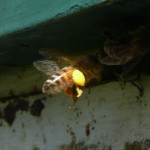Live from the Hive: April 2014
 “First Pollen” by Annie Watson, Thistle Hill Studio
“First Pollen” by Annie Watson, Thistle Hill Studio
As soon as the weather warms up in April (we hope!) the bees will begin to collect pollen from the early-blooming plants. In Vermont, the first ones are pussy willow, goat willow, and red maple. Keep a lookout for that red “glow” on the hillsides in April. It’s easily seen on a rainy day. Get up close to see the colorful red maple flower and maybe even a honey bee on it. Oddly, red maple pollen is a rather drab grey-brown in color. Willow pollen is pale yellow.